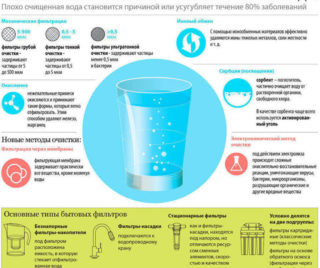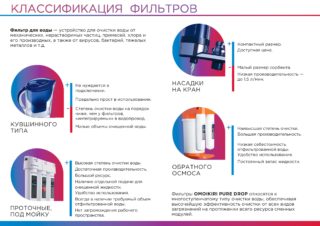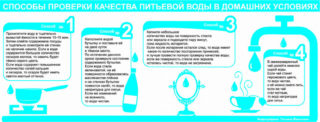Everyone should take care of the quality of tap water, including the owners of a centralized water supply system. But this is especially important for the owners of country houses and summer cottages. In the first case, specialized organizations carry out control over the liquid from the tap. The owner of the house is responsible for his own well. Natural water can contain sand and silt inclusions, contain pathogenic microorganisms and toxic compounds. To maintain health and protect household appliances from liming, it is necessary to select a water purification system depending on its composition and connect suitable equipment.
Requirements for safety and quality of water
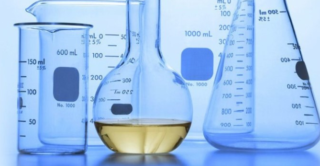
In the Russian Federation, quality standards for drinking water are regulated by SanPiN 2.1.4.1074-01 and GOST R 51232 - 98. According to these documents, drinking water must be:
- safe in epidemiological and radiation terms;
- harmless in composition;
- favorable organoleptic properties.
Epidemiological safety is determined by compliance with microbiological and parasitological criteria. If the liquid does not reach the required quality, it must be purified. In order to choose the right household water treatment equipment, it is necessary to conduct a laboratory analysis and identify the main problems.
The main methods of purification of drinking water
- mechanical, including settling;
- physical - ultraviolet disinfection, boiling, distillation, reverse osmosis, hydro-wave technique;
- chemical with the use of chlorine, fluorine, ozone, complexones - organic substances that contribute to the removal of mineral pollutants;
- physicochemical - silver ionization, electrolysis;
- biological with the use of bacteria-purifiers.
An interesting technique of hydrodynamic cavitation, based on the appearance in the water flow of voids filled with a gaseous component. With a vortex effect or the influence of ultrasound generated by a special apparatus - a cavitator, the liquid is not only cleaned, but changes its physicochemical properties, becomes "soft" and "curative".
All methods of water purification affect various types of contaminants, therefore, their use is due to the composition of the liquid in each case.
When taking water from surface sources, special filtering stations are used to supply cities and towns. First, the liquid is purified in several stages - coagulation, flocculation and sediment extraction. Thanks to special means, in the first two stages, unsafe compounds turn into flakes that are easy to remove.
Varieties of systems
- Iron removal stations. In the majority of reagent filter media for deferrization, the potential of a powerful oxidizing agent, manganese oxide, is used.
- Air aeration.Reagent-free purification method based on oxygen enrichment. It leads to the oxidation of iron and manganese and their precipitation. This type of purification can be carried out both on a pressure head and on a non-pressure basis.
- Electrochemical aeration. A modern method based on the reactions of substances using electrical impulses. Thanks to this method of aeration, it is possible to effectively purify liquids with a high content of ferrous compounds and ammonium. Technological differences from the standard aeration process are low noise, compact size, economy in terms of energy consumption, ease of use even in winter.
- Adsorption. Sorption cartridges are filled with: activated carbon, silicate gel, aluminosilicate, zeolites. Highly porous substances catch and retain harmful organic inclusions in microscopic pores. The water becomes clarified, acquires a pleasant smell and taste. But sorption cartridges quickly become clogged, they need to be changed frequently.
- Membrane cleaning, including reverse osmosis. Harmful impurities are retained by special membranes, and only water molecules pass through the micropores. Nanotechnology is used to create membrane barriers.
- Disinfection devices. With their help, pathogenic microorganisms are removed. Most of them work on the basis of processing with ultraviolet rays.
- Ion exchange filtration for softening - cationic or anionic. In the process of ion exchange, the liquid is cleared of hardness salts, ammonia compounds. The device consists of one flask or several containers filled with ion exchange resins. The substance includes weakly bound sodium ions. When the water flow passes through the resin layer, calcium and magnesium ions are retained in it. Instead, neutral sodium ions are released into the water.
Gradually the sodium part of the filler is depleted and the resin needs to be regenerated. This is done with edible salt dissolved in water. For restoring solutions, a special tableted salt is taken. A quality product is required: the tablets should not crumble and crumble, but dissolve evenly in water without stirring. No plaque should appear on the walls of the container where dissolution is taking place, and sediment should not appear on the bottom.
Ion exchange plants are capable of softening and purifying even poor quality water. Their disadvantage is the need to buy salt or new cartridges.
Modern water purification systems certainly include aeration or ion exchange filtration.
There are also large modular and containerized water treatment plants, both stationary and mobile. They are rarely used in everyday life, more often for industrial purposes.
Rating of the best filters
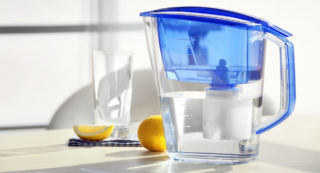
Water filtration is carried out in various ways; many brands produce equipment suitable for different cases. The most popular are:
- "Aquaphor". Under this brand, they produce both portable filter jugs and whole complexes with full cleaning and aeration deferrization, which cost about 130,000 rubles.
- "Aquadin". Offers compact ion-exchange filters for softening and deferrizing water, removing manganese at a price of 81,000 rubles.
- Aquacenter and Nortex. They produce multistage systems, the connection of which goes directly to the outlet of the water tap in the kitchen.
- "Astra Ferrum". Manufactures complex autonomous water treatment plants with nanofiltration effect.
- "Atoll". Offers a variety of filtration equipment options - from replaceable cartridges to large units. The cost is affordable, the cleaning system can be purchased for 14,000 rubles.
- "Barrier". The brand presents BWT AQUADIAL water purification systems, which are easy to connect and use, with aeration and ion-exchange resin filtering devices.Their price is from 140,000 rubles.
- "Geyser". Produces various water purifiers. A mobile water treatment station in the form of a mobile ion-exchange column is in special demand. It makes it possible to purify water from surface sources or artesian wells.
- "Deferum". Produces multistage units for domestic and industrial needs. The price tag starts at $ 2,990.
- Distel. Sells water treatment systems for cottages, country houses and summer cottages, the design of which depends on the indicators of the aquatic environment. Cost - from 21,000 rubles.
- "Christmas tree". Column-type and cabinet-type equipment with this name is offered by the Russian company "Tsentrgazservice". An integrated water treatment system will cost about 170,000 rubles. But there are also budget options.
- "Katun". The home treatment plant is produced in Altai, at the Rotor plant. It does not take up much space in the room, it is inexpensive - only 1230 rubles.
- "Zepter". Produces filtration units that can be installed under sinks and on worktops. They work according to a five-stage system, including reverse osmosis technology.
Under the brands "Baikal" and "Ermak" they produce automatic stations of modular-block type - a good option for industrial purposes.
Criterias of choice
- Qualitative indicators of the aquatic environment. A laboratory analysis is required. If there is an abundance of coarse impurities, a 400 micron coarse mesh filter is required. The primary use of thin filtering devices is unreasonable: they will quickly fail.
- The amount of fluid consumed. One family member needs at least two and a half liters of water a day.
- Dimensions of the device. Most often, productive and powerful filters have impressive dimensions. This moment must be taken into account already at the stage of creating a house project in order to find a place for the unit.
- The degree of automation. The devices can operate in standard mode and under conditions of recovery of filtration loading. Switching of the installation is required from time to time. It is performed manually or automatically.
- Spending on the device itself, its connection and consumables.
It is generally accepted that after passing the water flow through the filtering equipment, the liquid loses not only harmful, but also useful qualities. For the return, devices have been developed that saturate liquids with the necessary substances. Check if they are included in the kit.
It is also necessary to take into account the type of sewage system, since all impurities will sooner or later end up in it.
When using chemical reagents, sewage must not be directed to closed-loop sewage systems and those that work at the expense of beneficial microorganisms, for example, to the Topas septic tanks. Biobacteria will simply die.
Brand or high cost doesn't always mean perfect quality. To buy a really suitable device, you need to take into account the individual indicators of water, as well as reviews on the World Wide Web and recommendations of specialists. Only after this can a balanced and well-grounded decision be made on the installation of a water treatment system.

